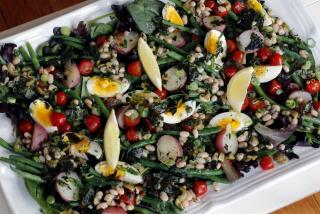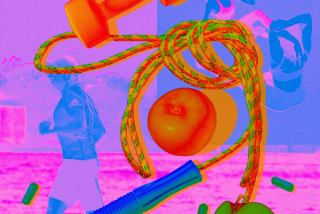4 Diet Books Light on Nutrition, Group Says
- Share via
Four leading diet books are based on eating plans that are nutritionally unwise, says a new report by the Center for Science in the Public Interest, a Washington-based consumer group focusing on food and nutrition.
Bonnie Liebman, the center’s director of nutrition, evaluated 10 books and rated four of their diets nutritionally unacceptable:
*
* “Dr. Atkins’ New Diet Revolution,” by Robert Atkins, severely restricts carbohydrates to help the body burn fat and allows dieters to eat meat, poultry, seafood, eggs, cheese, butter, cream, oil, nuts and artificial sweeteners.
Drawback: Too high in saturated fat, too low in fruits and whole grains, fiber and calcium, the center said.
*
* “Protein Power,” by Michael R. Eades and Mary Dan Eades, stresses that limiting carbohydrates helps trim pounds.
Drawback: Too high in saturated fat, too low in calcium; restricts some healthful foods, including whole grains, according to the center.
*
* “Sugar Busters!” by H.L. Steward, M.C. Bethea, S.S. Andrews and L.A. Balart, also claims that carbohydrates--especially refined sugar--is the culprit for weight gain and thus recommends eliminating all sugar, white flour, carrots, corn and beets.
Drawback: Inconsistent advice, low in calcium, and restricts some healthful foods, including bananas and carrots, according to the center.
*
* “The Carbohydrates Addict’s Diet,” by Rachel F. Heller and Richard F. Heller, also takes the premise that carbohydrates are solely responsible for weight gain. It features high-fat foods and selected vegetables.
Drawback: Inconsistent advice, according to the center, and too high in saturated fat.
*
The six diets that made the cut for being acceptable all offer a broad range of food, are generally low-fat and are what nutritionists call “low-calorie dense,” meaning you can eat a lot but fill up on foods less likely to put on pounds.
But even these six “acceptable” diets aren’t perfect, the center notes, and will need to be modified in some cases for people with special health problems:
* “The Zone,” by Barry Sears, a low-fat protein regimen that purportedly helps weight loss by keeping insulin levels in “The Zone.”
* “Dieting With the Duchess,” by Sarah Ferguson and Weight Watchers, in which dieters use a point system to choose from low-fat dairy, poultry, meat, seafood, fruits, vegetables, bread, pasta and cereal.
* “Volumetrics,” by Barbara Rolls and Robert A. Barnett, which suggests that cutting calorie density with soups and high-fiber fruits and vegetables helps promote weight loss.
* “The Pritikin Principle,” by Robert Pritikin. The granddaddy of low-fat diet books offers limited amounts of skinless poultry, seafood and meat and generous servings of fruits, vegetables, pasta, soups, salads and low-fat dairy products.
* “Choose to Lose,” by Ron Goor and Nancy Goor, which focuses on eliminating fat as the essential ingredient for shedding pounds.
* “Eat More, Weigh Less,” by Dean Ornish, which emphasizes that a fat-free diet of healthy foods can help you to feel full and still lose weight.
*
More information on the diets is available in the May issue of Nutrition Action, a newsletter published by the center, and on its Web site: https://www.cspinet.org.


